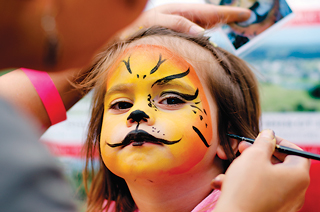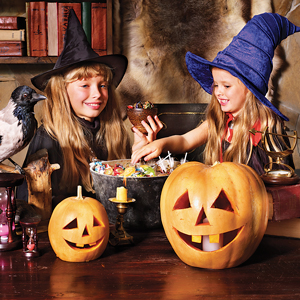I’ve always loved Halloween. In fact, I encourage dressing up all the time with my kids. Capes. Pirate patches. Tutus. My daughters’ closets are filled with an assortment of costume pieces and parts. One minute they are fairies, the next knights. But when my older daughter was three, she tested my parenting allegiance to imaginative play when she declared herself a boy.
My daughter’s obsession with boy-hood began with an intense adoration for Nickelodeon’s Diego. Like many preschoolers, she found this animal rescuer worthy of high praise, especially since he lived in South America like my husband had during his days as a Peace Corps volunteer. I never minded my daughter being a daddy’s girl. I knew we’d had our share of fun, too. But when I was pregnant with my second child and she started introducing herself as the “big brother,” I began to worry. As an educator, I knew the value of role-playing and how it helped children negotiate gender roles, among other things. But I was struggling to embrace my daughter’s attitude of Why can’t every day be Halloween?
In Einstein Never Used Flashcards, Kathy Hirsh-Pasek and Roberta Michnick Golinkoff wrote about the importance of letting your children initiate their own fun, so I decided to let it run its course. After all, the authors reasoned, “[Pretend play] gives children a sense of power. And for people [children] who are being told what to do every minute of the day, having a sense of power is not only delightful, it’s instructive.”
This may be one reason dressing up has such a long tradition. All Hallows Eve dates back to the 1500s in Scotland. While adults largely participated in this Celtic practice, children going guising around neighborhoods became fashionable in North America by the early 1900s. This paved the way for costume parties and parades. And we all know the rest of the story. It wasn’t long before Halloween turned into a billion dollar industry. Stores now line their aisles with tricks and treats months in advance.
 According to OneStep Retail Solutions, since 2005, consumer spending on Halloween has increased by more than fifty-five percent. In a survey conducted last year, consumers said they spend an average of $75 per household, for a grand total of about $6.9 billion dished out as a nation – on the purchases of costumes for kids and adults, decorations, party favors, and of course, candy.
According to OneStep Retail Solutions, since 2005, consumer spending on Halloween has increased by more than fifty-five percent. In a survey conducted last year, consumers said they spend an average of $75 per household, for a grand total of about $6.9 billion dished out as a nation – on the purchases of costumes for kids and adults, decorations, party favors, and of course, candy.
As a parent who wants her kids to make healthy food choices all year long, I struggle a little bit with the sugar and artificial dye overload that is Halloween. Admittedly, I’d like to shift the balance of fun to the dress-up side of the holiday. Besides, if we’re putting all of this money (and time) into Halloween – costuming our kids, ourselves, and our pets, why not help our children really get something out of it?
Like Molly Snow, who lives in Henrico with her family. She says her three elementary school-age kids have always loved Halloween and any chance to dress up. The excitement starts building in the summer for her 6-year-old daughter, Reagan. “She will have changed her mind three times by the time she arrives at the perfect plan for this year’s costume.” Molly says that for her boys, 10-year-old Ethan and 9-year-old Jack, “it has mainly been about the opportunity to dress up as someone they admire, which has required tapping into their creativity a bit more some years than others.”
For the Snows, this kind of creative energy is prevalent year-round thanks to a well-stocked playroom and a parental commitment to inspiring imaginative play. “We do not have costumes out only at Halloween time,” says Molly. “They [costumes] go into bins and baskets in our playroom and are out and visible should the creative mood strike. It doesn’t have to be an expensive undertaking to create a dress-up box or area of your playroom, nor do costumes have to be store-bought. Over the years I have kept our bins supplied with old jewelry and clothes of mine, old military uniform parts from my dad, pieces of fabric, etc.”
Beyond having the satisfaction of raising creative kids, Molly and her husband have reaped the benefits of encouraging dress-up at home. “Over the years we have watched – and the little entrepreneurs even charged admission to some – performances featuring superheroes, dance, gymnastics, animals, and sports stunts to name a few,” says Molly.
During the year, her kids look forward to participating in themed dress-up activities at school like sports-team day or book character day. According to Molly, the boys begin planning their Halloween costumes as soon as the family decorates the house at the beginning of October. And Molly admits that while her three kids are crazy about the dress-up side of trick-or-treating, “that is not to say that the candy is not a factor. They know exactly which houses give out full-size candy bars.”
 To get your children excited about dressing up for Halloween, Molly suggests taking time to talk about people that the kids admire and how that costume might be created. She also recommends sharing your enthusiasm with the kids. “Let them know that you’re excited and willing to help them make a costume.”
To get your children excited about dressing up for Halloween, Molly suggests taking time to talk about people that the kids admire and how that costume might be created. She also recommends sharing your enthusiasm with the kids. “Let them know that you’re excited and willing to help them make a costume.”
Licensed professional counselor and mother of two, Jennifer Shively Davis, explains that Halloween gives older children, who might otherwise think it uncool, permission to play pretend. Jennifer claims this is her favorite part of dress-up, whether it’s happening at Halloween or not. “It allows children to imagine themselves from a different perspective. They can play out a variety of emotions and learn how to figure out what someone else would do, which ultimately helps children become more empathetic.”
Jennifer says there are also a host of cognitive benefits to pretend play. “As children determine what the story is going to be about or what’s going to happen next, they not only develop their reading and language skills, but they also practice sequencing and problem solving as well as conflict resolution.” That’s why, according to Jennifer, “Kids need the free time and open space to come up with their own ideas.”
Furthermore, according to Jennifer, research shows that kids who play pretend are less aggressive, stay focused, and control their impulses. So if your kids have outgrown their dress-up box, consider encouraging creative pursuits around Halloween itself. Jennifer suggests that kids use their electronic devices to make trailers and commercials that work with their costumes. For example, her 10-year-old son will go into the backyard to “make a movie.” Acting is a great way to maintain dress-up’s social acceptability while still allowing kids to practice negotiating emotional situations longer.
If you start early enough, you really can get your kids more into the creative aspect as opposed to the candy side of Halloween. In fact, the more you stretch out the imaginative elements of the holiday, the greater your chances of keeping your kids in touch with their playfulness all year long.
When my daughter wanted to wear her Diego costume after Halloween had passed, I told you I had my doubts. I remember asking her why she was so adamant about wearing her jungle gear when all her friends were wearing gowns. “I don’t want to stand around looking pretty. I want to have my own adventure.”
Then, while fixing dinner one evening, we had an adventure – in the form of a kitchen fire. As the flames blazed, I calmly headed to the closet for the fire extinguisher. I told my daughter to stand back, pulled the pin, and sprayed the fire. “Wow!” she whispered, as the white foam coated the countertop. When everything was under control, I couldn’t help but laugh. Knowing it was safe to approach, she gave me a big hug. “Mommy, when I grow up, I want to be just like you.”
From that moment on, my daughter was back. Apparently, my stint as an amateur firefighter showed her mommies also have adventures. Granted, she asked Santa for a Peter Pan costume that year, but her desire to role-play across genders no longer phased me. In fact, I celebrated my daughter for learning early on what it took me years to realize: There’s incredible power in enjoying the best of both worlds. Boy or girl, that is exactly the kind of kid I want to raise, and may be the biggest treat about Halloween: At least one day every year, you can be anything you want to be.
Encouraging Costumes Before Candy
 Although many families with children who have uber-strict diets or food allergies have to do it, good luck trying to get your kids to completely forgo the candy mountain this Halloween. We recommend these strategies to at least help families get as enthusiastic about dressing up as they do about pigging out.
Although many families with children who have uber-strict diets or food allergies have to do it, good luck trying to get your kids to completely forgo the candy mountain this Halloween. We recommend these strategies to at least help families get as enthusiastic about dressing up as they do about pigging out.
1. It’s not too late to organize a neighborhood costume exchange this year. At this kind of get-together, it’s easy to combine Halloween costumes, or pick up accessories to complete a look. Kids can also collaborate and come up with a cool theme. (An 8-pack of crayons beautified our neighborhood last year!)
2. Inspire your kids to not only choose their own Halloween identity, but also to create it. Goodwill and other second-hand stores are a great place to start. So no one sews in the family? No biggie. Start with boxes, ductwork tubing, and other recycled materials to get the creative juices flowing. Think robot, gift-wrapped box, stop light, or a cell phone.
3. Help your kids plan a book-trade party this month to encourage dressing up. Friends can come as a favorite literary character and bring a new or used book from home to trade with a party guest.
4. Try to encourage your kids to participate in spirit days (book character themes, career days, crazy hair days) at school and on their sports teams. There are also dress-up and theme days at local parks and during some camps.
5. Attending costume-friendly events during October lets kids show off their creativity.




